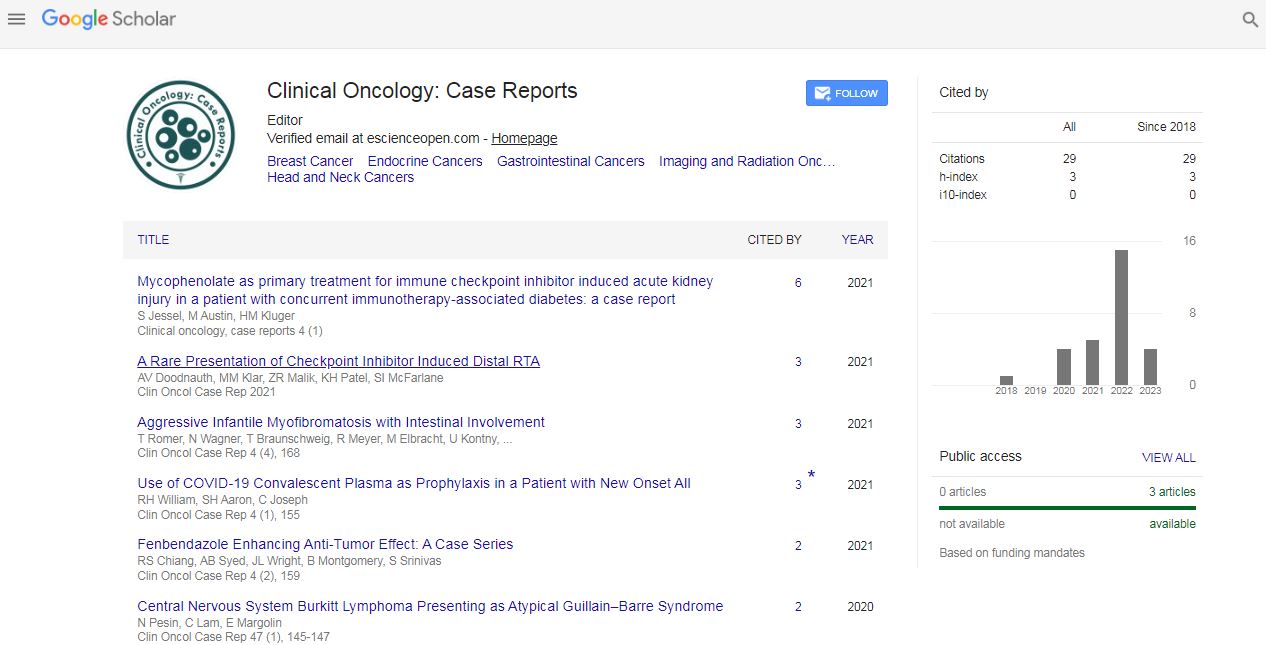Perspective, Cocr Vol: 7 Issue: 7
Cysts and Cancer: Understanding the Complex Relationship Between Benign Growths and Malignancies
George Orwell*
Department of Oncology, Sir Anthony Mamo Oncology Centre, Imsida, Malta
*Corresponding Author: George Orwell
Department of Oncology, Sir Anthony Mamo Oncology Centre, Imsida, Malta
E-mail: orwellorge@gov.mt
Received: July 05, 2024; Manuscript No: COCR-24-158531
Editor Assigned: July 11, 2024; PreQC Id: COCR-24-158531 (PQ)
Reviewed: July 18, 2024; QC No: COCR-24-158531 (Q)
Revised: July 25, 2024; Manuscript No: COCR-24-158531 (R)
Published: July 29, 2024; DOI: 10.4173/cocr.7(7).365
Citation: Orwell G., (2024) Cysts and Cancer: Understanding the Complex Relationship Between Benign Growths and Malignancies. Clin Oncol Case Rep 7:7â??â??â??â??â??â??â??
Abstract
Cysts are fluid-filled or semi-solid sacs that can develop in various tissues and organs of the body. While many cysts are benign, their relationship with cancer is an area of significant clinical interest. Some cysts may serve as precursors to malignant transformation, while others coexist with or mimic cancer. This article explores the intricate relationship between cysts and cancer, focusing on their classification, pathophysiology, diagnostic challenges, and implications for patient management. By examining common examples such as ovarian cysts, pancreatic cysts, and cystic tumors of the breast and liver, this review sheds light on how cysts can play a role in cancer progression. The potential of advanced imaging, biomarkers, and minimally invasive techniques in distinguishing benign from malignant cysts is also discussed, along with future directions for research and treatment strategies.
Keywords: Cyst; Cancer; Cystic neoplasms; Ovarian cyst; Pancreatic cyst; Malignancy; Biomarkers; Diagnostic imaging; Precancerous lesions; Tumor progression
Introduction
Cysts are common findings in clinical practice and can occur in virtually any tissue. They range from benign, asymptomatic lesions to those that may raise concerns for malignancy. Differentiating benign cysts from malignant or precancerous cystic tumors is crucial for determining the appropriate management and prognosis. This article provides a comprehensive overview of the types of cysts associated with cancer, their mechanisms, diagnostic approaches, and implications for treatment.
Types of cysts related to cancer conceptual framework
Benign ovarian cysts: Functional cysts such as follicular cysts and corpus luteum cysts are typically benign and self-limiting.
Pathological cysts: Endometriomas and dermoid cysts may be benign but can mimic malignant processes.
Malignant transformation: Certain ovarian cysts, such as mucinous or serous cystadenomas, have the potential to transform into cystadenocarcinomas.
Pancreatic cysts
• Non-Neoplastic cysts: These include pseudocysts, often caused by pancreatitis.
• Neoplastic cysts: Intraductal Papillary Mucinous Neoplasms (IPMNs) and Mucinous Cystic Neoplasms (MCNs) are precancerous lesions that can progress to pancreatic ductal adenocarcinoma.
Breast cysts
• Simple cysts are generally benign but require differentiation from complex cystic structures, which may harbor malignancy.
• Phyllodes tumors, though rare, can present as cystic masses and vary from benign to malignant.
Liver cysts: Simple hepatic cysts are often benign, but cystic liver lesions such as biliary cystadenomas may transform into cystadenocarcinomas.
Renal cysts: Bosniak classification is used to assess the malignancy risk of renal cysts. Complex cystic lesions, particularly Bosniak category III and IV, warrant closer evaluation for renal cell carcinoma.
Pathophysiology of cysts and their link to cancer
Genetic mutations: Mutations in genes such as KRAS, TP53, and BRCA1/2 have been implicated in the malignant transformation of cystic neoplasms.
Chronic inflammation: Conditions like chronic pancreatitis or endometriosis create an inflammatory microenvironment that promotes cyst development and increases cancer risk.
Angiogenesis and growth factors: Dysregulated angiogenesis and secretion of growth factors (e.g., VEGF, EGF) within cystic lesions can support tumorigenesis.
Epigenetic modifications: DNA methylation and histone modifications may drive the progression from benign cysts to malignancy.
Diagnostic Challenges and Approaches
Imaging techniques
Ultrasound: Commonly used for initial evaluation of cysts, particularly in the breast, liver, and ovaries.
CT and MRI: Provide detailed characterization of cystic lesions, including wall thickness, septations, and contrast enhancement patterns.
Endoscopic Ultrasound (EUS): Critical for assessing pancreatic cysts and obtaining fluid samples for analysis.
Biomarkers
CA-125: Elevated in ovarian cancer, but also in benign conditions.
CEA and Amylase: Help differentiate pancreatic pseudocysts from mucinous neoplasms.
AFP and CA 19-9: Used in evaluating liver cystic lesions and pancreatic malignancies.
Cyst fluid analysis
• Cytological examination of cyst fluid for malignant cells.
• Biochemical analysis for markers like CEA, glucose, and amylase.
 Spanish
Spanish  Chinese
Chinese  Russian
Russian  German
German  French
French  Japanese
Japanese  Portuguese
Portuguese  Hindi
Hindi 